The Li2SO4–Na2SO4 System for Thermal Energy Storage
Abstract
:1. Introduction
2. Materials and Methods
2.1. Theoretical Evaluation and Materials Preparation
2.2. Synthesis
2.3. Thermodynamic Characterization
2.4. Structural Analysis
3. Results and Discussion
3.1. Theoretical Analysis Results
3.2. Experimental Results and Discussion
3.2.1. The Li2SO4/Na2SO4 50/50 System
3.2.2. The Li2SO4/Na2SO4 79/21 System
3.3. Thermal Energy Storage Performance
4. Conclusions
Author Contributions
Funding
Acknowledgments
Conflicts of Interest
References
- Doppiu, S.; Dauvergne, J.-L.; del Palomo Barrio, E. Solid-State Reactions for the Storage of Thermal Energy. Nanomaterials 2019, 9, 226. [Google Scholar] [CrossRef] [PubMed]
- BCS Incorporated (March 2008). Available online: http://www1.eere.energy.gov/manufacturing/intensiveprocesses/pdfs/waste_heat_recovery.pdf (accessed on 19 December 2018).
- Siegel, N.P. Thermal energy storage for solar power production. Wiley Interdiscip. Rev. Energy Environ. 2012, 1, 119–131. [Google Scholar] [CrossRef]
- Materials Roadmap Enabling Low Carbon Energy Technologies. Available online: http://ec.europa.eu/research/industrial_technologies/pdf/materials-roadmap-elcet13122011_en.pdf (accessed on 19 December 2018).
- Energy Roadmap 2050. Available online: http://eur-lex.europa.eu/LexUriServ/LexUriServ.do?uri=COM:2011:0885:FIN:EN:PDF (accessed on 19 December 2018).
- EASE/EERA Energy Storage Technology Development Roadmap towards 2030. Available online: http://ease-storage.eu/easeeera-energy-storage-technology-development-roadmap-towards-2030 (accessed on 19 December 2018).
- Lane, G.A.; Shamsundar, N. Solar Heat Storage: Latent heat Materials, Volume I: Background and Scientific Principles; CRC Press: Boca Raton, FL, USA, 1983. [Google Scholar]
- Zalba, B.; Marın, J.M.; Cabeza, L.F.; Mehling, H. Review on thermal energy storage with phase change: Materials, heat transfer analysis and applications. Appl. Therm. Eng. 2003, 23, 251–283. [Google Scholar] [CrossRef]
- Felderhoff, M.; Urbanczyk, R.; Peil, S. Thermochemical heat storage for high temperature applications—A review. Green 2013, 3, 113–123. [Google Scholar] [CrossRef]
- Steinfeld, A.; Palumbo, R. Solar thermochemical process technology. Encycl. Phys. Sci. Technol. 2001, 15, 237–256. [Google Scholar] [CrossRef]
- Salunkhe, P.B.; Shembekar, P.S. A review on effect of phase change material encapsulation on the thermal performance of a system. Renew. Sustain. Energy Rev. 2012, 16, 5603–5616. [Google Scholar] [CrossRef]
- Chen, B.; Liu, T.-H.; Jiao, H.; Jing, X.-P. Phase transitions and energy storage properties of some compositions in the (1−x) Li2SO4−xNa2SO4 system. Phase Transit. 2014, 87, 629–640. [Google Scholar] [CrossRef]
- Førland, T.; Krogh-Moe, J. The structure of the high-temperature modification of sodium lithium sulfate. Acta Crystallogr. 1958, 11, 224–225. [Google Scholar] [CrossRef]
- Freiheit, H.-C.; Kroll, H.; Putnis, A. The trigonal-to-cubic phase transition in LiNaSO4: An X-ray and calorimetric study. Z. Krist. 1998, 213, 575–584. [Google Scholar] [CrossRef]
- Suleiman, B.M.; Lundén, A.; Karawacki, E. Heat transfer and ion migration in the system Li2SO4–Na2SO4. Solid State Ion. 2000, 136, 325–330. [Google Scholar] [CrossRef]
- Venudhar, Y.C.; Iyengar, L.; Krishna Rao, K.V. Phase transitions in sodium lithium sulphate. J. Mater. Sci. Lett. 1985, 4, 1010–1013. [Google Scholar] [CrossRef]
- Kanashiro, T.; Yamanishi, T.; Kishimoto, Y.; Ohno, T.; Michihiro, Y.; Nobugai, K. Nuclear magnetic relaxation and ionic conductivity in LiNaSO4. J. Phys. Soc. Jpn. 1994, 63, 3488–3493. [Google Scholar] [CrossRef]
- Massiot, D.; Bessada, C.; Echegut, P.; Coutures, J.P.; Taullele, F. High temperature NMR study of lithium sodium sulfate. Solid State Ion. 1990, 37, 223–229. [Google Scholar] [CrossRef]
- Teeters, D.; Frech, R. Raman and infrared reflectivity spectra of 6LiNaSO4 and 7LiNaSO4. J. Chem. Phys. 1982, 76, 799–804. [Google Scholar] [CrossRef]
- Teeters, D.; Frech, R. Temperature dependence of the low-frequency vibrational modes in LiNaSO4 and LiKSO4. Phys. Rev. B 1982, 26, 5897. [Google Scholar] [CrossRef]
- Mata, J.; Solans, X.; Calvet, M.T.; Molera, J.; Font-Bardia, M. X-ray structural characterization, Raman and thermal analysis of LiNaSO4. The phase diagram of the Li2SO4-Na2SO4 system. J. Phys. Condens. Matter 2002, 14, 5211. [Google Scholar] [CrossRef]
- Zhang, M.; Putnis, A.; Salje, E.K.H. Infrared spectroscopy of superionic conductor LiNaSO4: Vibrational modes and thermodynamics. Solid State Ion. 2006, 177, 37–43. [Google Scholar] [CrossRef]
- Shakhovoy, R.A.; Sarou-Kanian, V.; Rakhmatullin, A.; Véron, E.; Bessada, C. High-temperature nuclear magnetic resonance study of phase transition kinetics in LiNaSO4. J. Appl. Phys. 2015, 118, 243906. [Google Scholar] [CrossRef]
- Saunders, N.; Miodownik, A.P. CALPHAD (Calculation of Phase Diagrams): A Comprehensive Guide; Elsevier: Amsterdam, The Netherlands, 1998; Volume 1, ISBN 0080528430. [Google Scholar]
- Chang, Y.A.; Chen, S.; Zhang, F.; Yan, X.; Xie, F.; Schmid-Fetzer, R.; Oates, W.A. Phase diagram calculation: Past, present and future. Prog. Mater. Sci. 2004, 49, 313–345. [Google Scholar] [CrossRef]
- Cacciamani, G. An Introduction to the CALPHAD Method and the COMPOUND Energy Formalism (CEF). Tecnol. Metal. Mater. Min. 2016, 13, 16. [Google Scholar] [CrossRef]
- Bale, C.W.; Bélisle, E.; Chartrand, P.; Decterov, S.A.; Eriksson, G.; Gheribi, A.E.; Hack, K.; Jung, I.H.; Kang, Y.B.; Melançon, J.; et al. FactSage thermochemical software and databases, 2010–2016. Calphad 2016, 54, 35–53. [Google Scholar] [CrossRef]
- Lutterotti, L.; Gialanella, S. X-ray diffraction characterization of heavily deformed metallic specimens. Acta Mater. 1998, 46, 101–110. [Google Scholar] [CrossRef]
- Rietveld, H. A profile refinement method for nuclear and magnetic structures. J. Appl. Crystallogr. 1969, 2, 65–71. [Google Scholar] [CrossRef]
- Schroeder, K.; Kvist, A.; Ljungmark, H. The Phase Diagrams of the Binary Systems Li2SO4–Na2SO4, Li2SO4–Rb2SO4, and Li2SO4–Cs2SO4. Z. Naturforsch. A 1972, 27, 1252–1256. [Google Scholar] [CrossRef]
- Nacken, R. On the Formation and Inversion of Mix-crystals and Double Salts in the Binary Systems of the Dimorphous Sulphates of Lithium, Sodium, Potassium and Silver. Neues Jahrb. Mineral. Geol. Beil. 1907, 24, 1–68. [Google Scholar]
- Suryanarayana, C. Structure and properties of nanocrystalline materials. Bull. Mater. Sci. 1994, 17, 307–346. [Google Scholar] [CrossRef]
- Rojas, R.M.; De Vidales, J.L.M.; Delgado, A.; Sinisterra, J.V. Microstructural and thermal characterization of basic and stoichiometric lithium phosphates, in relation with their catalytic activity. J. Solid State Chem. 1993, 106, 237–252. [Google Scholar] [CrossRef]
- Gil, A.; Medrano, M.; Martorell, I.; Lázaro, A.; Dolado, P.; Zalba, B.; Cabeza, L.F. State of the art on high temperature thermal energy storage for power generation. Part 1—Concepts, materials and modellization. Renew. Sustain. Energy Rev. 2010, 14, 31–55. [Google Scholar] [CrossRef]
- Grosu, Y.; Ortega-Fernández, I.; González-Fernández, L.; Nithiyanantham, U.; Baba, Y.F.; Al Mers, A.; Faik, A. Natural and by-product materials for thermocline-based thermal energy storage system at CSP plant: Structural and thermophysical properties. Appl. Therm. Eng. 2018, 136, 185–193. [Google Scholar] [CrossRef]
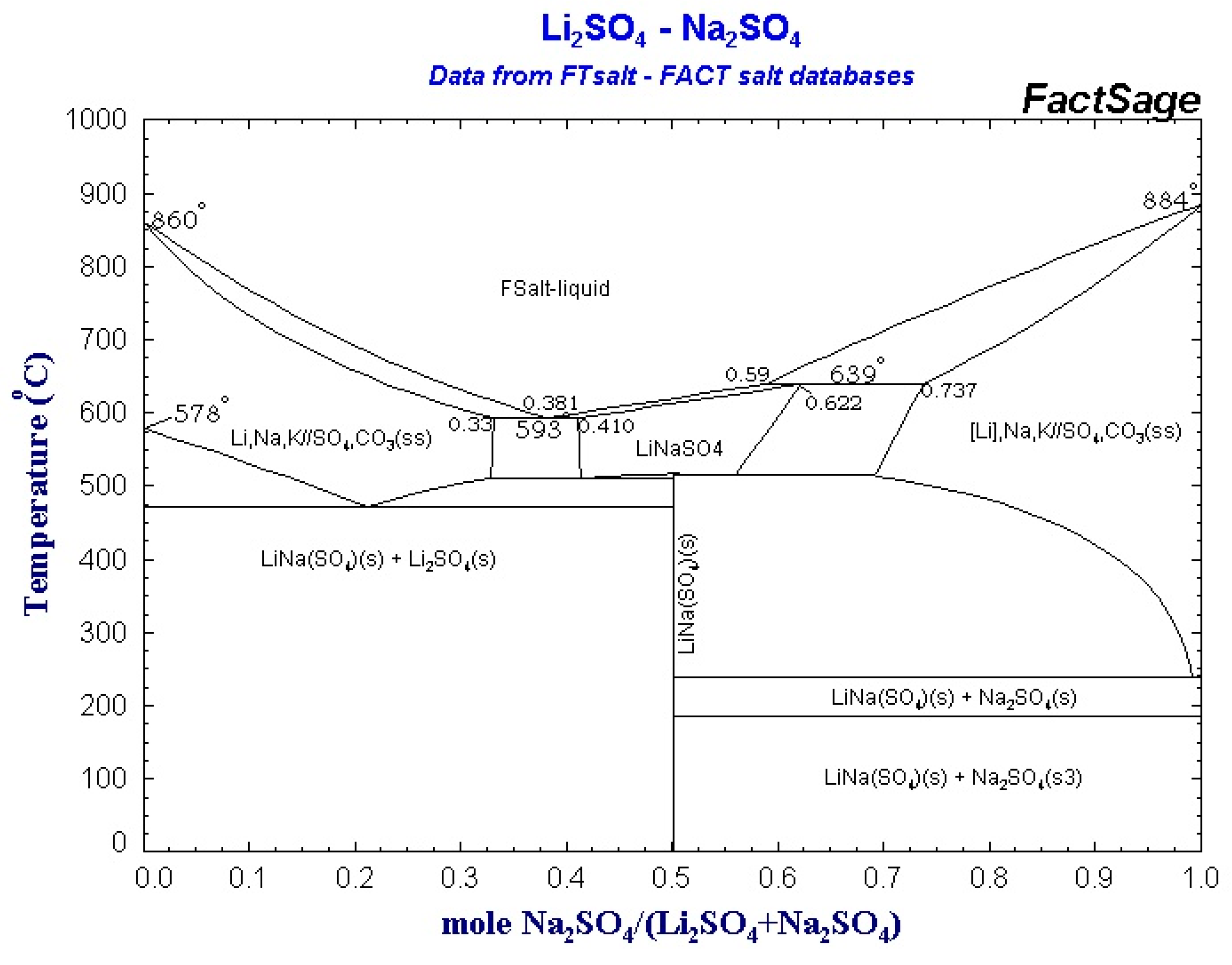
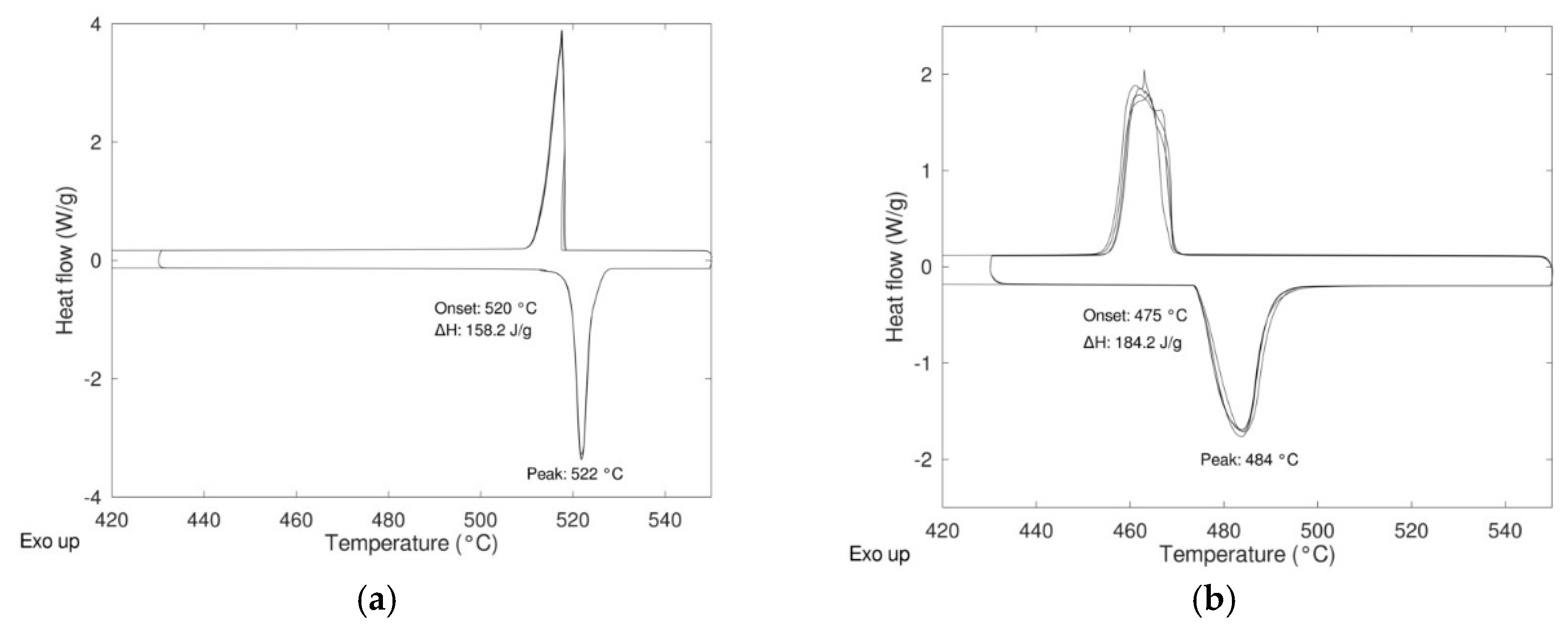
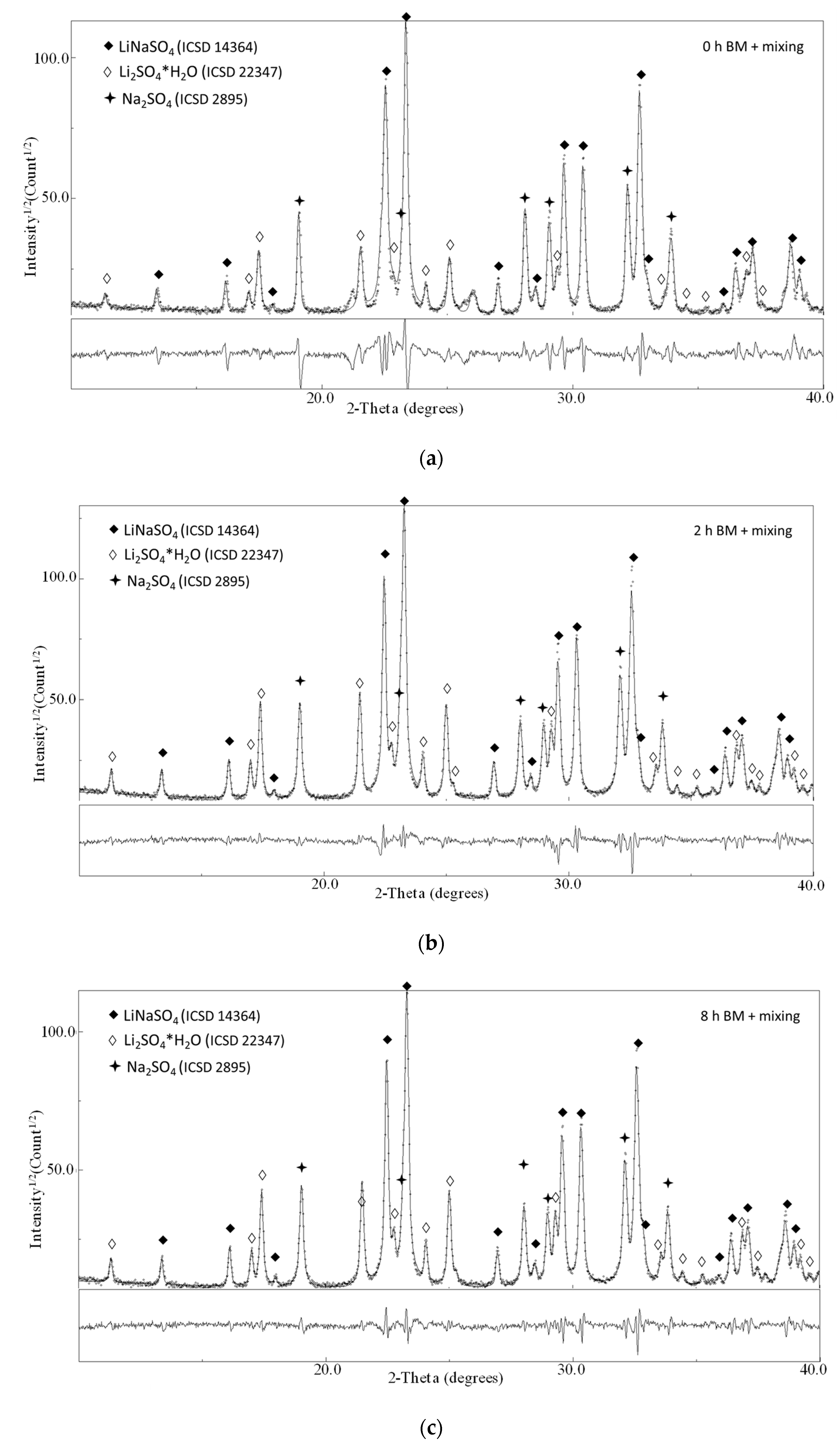
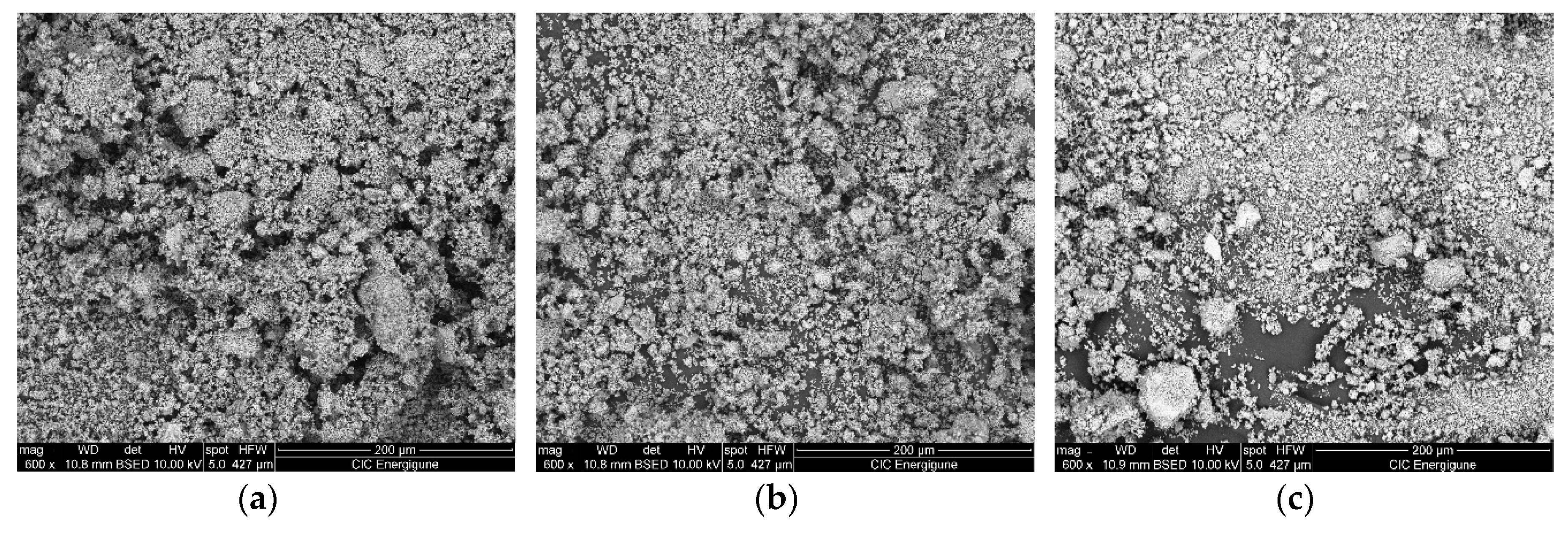
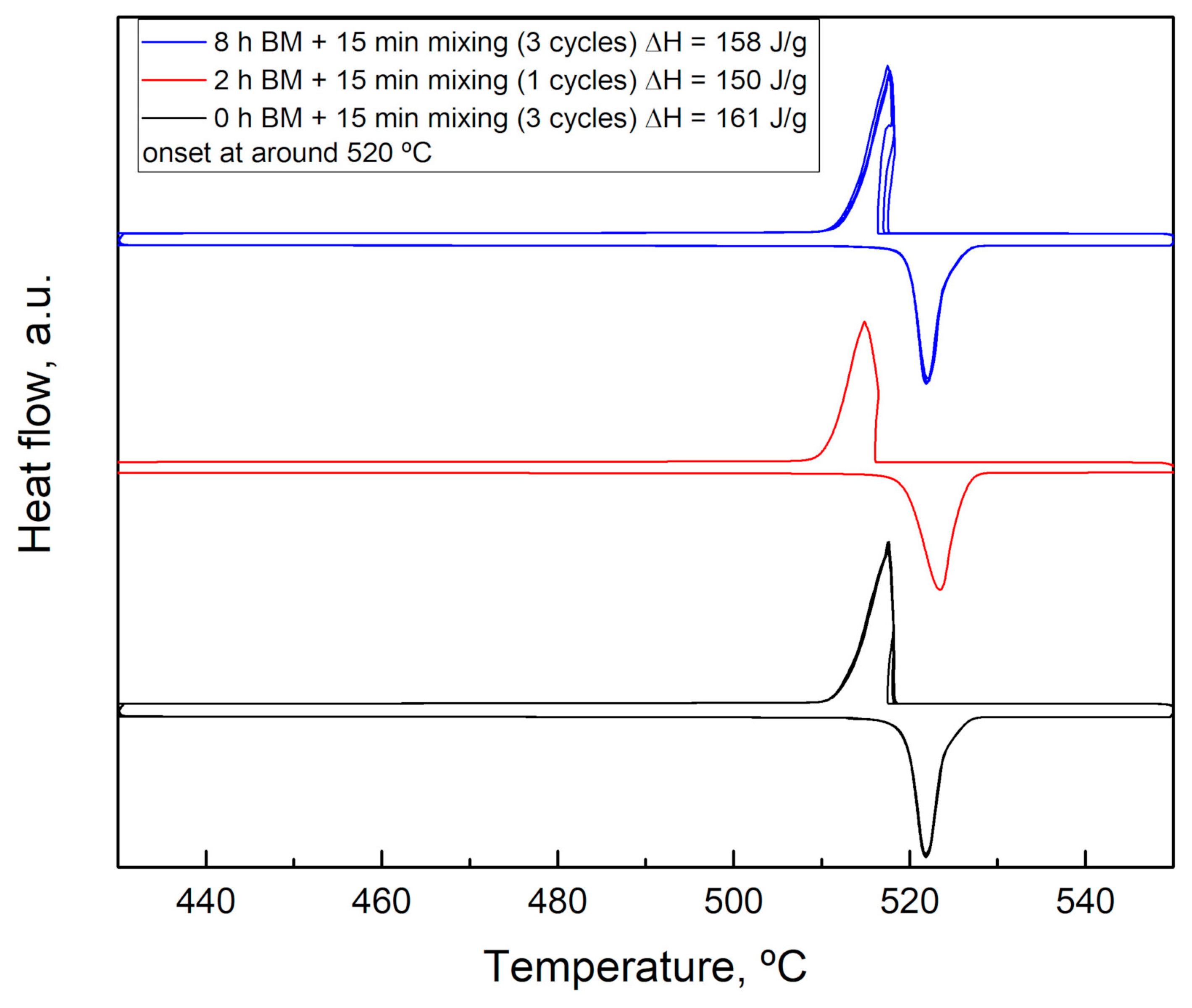
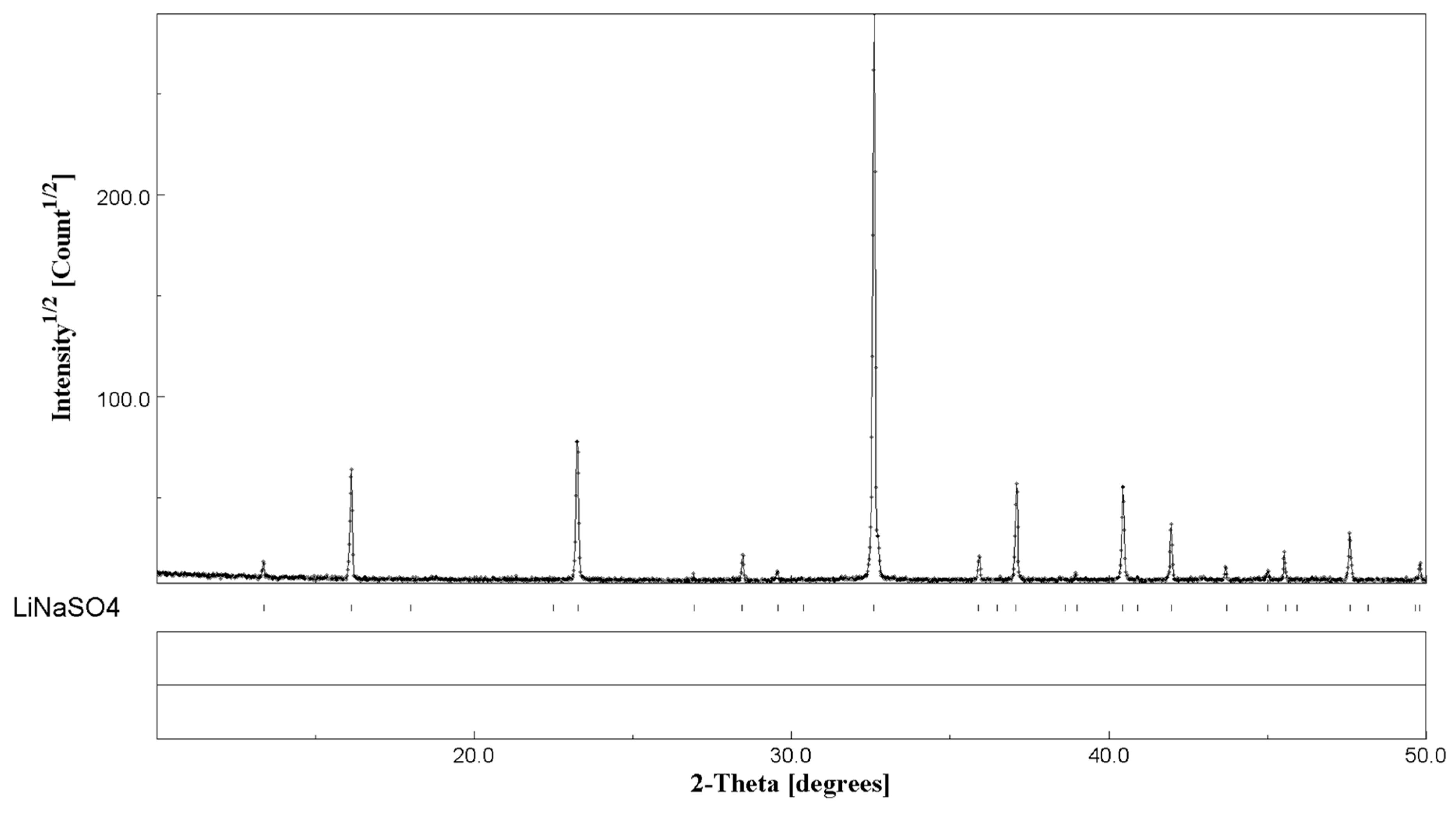
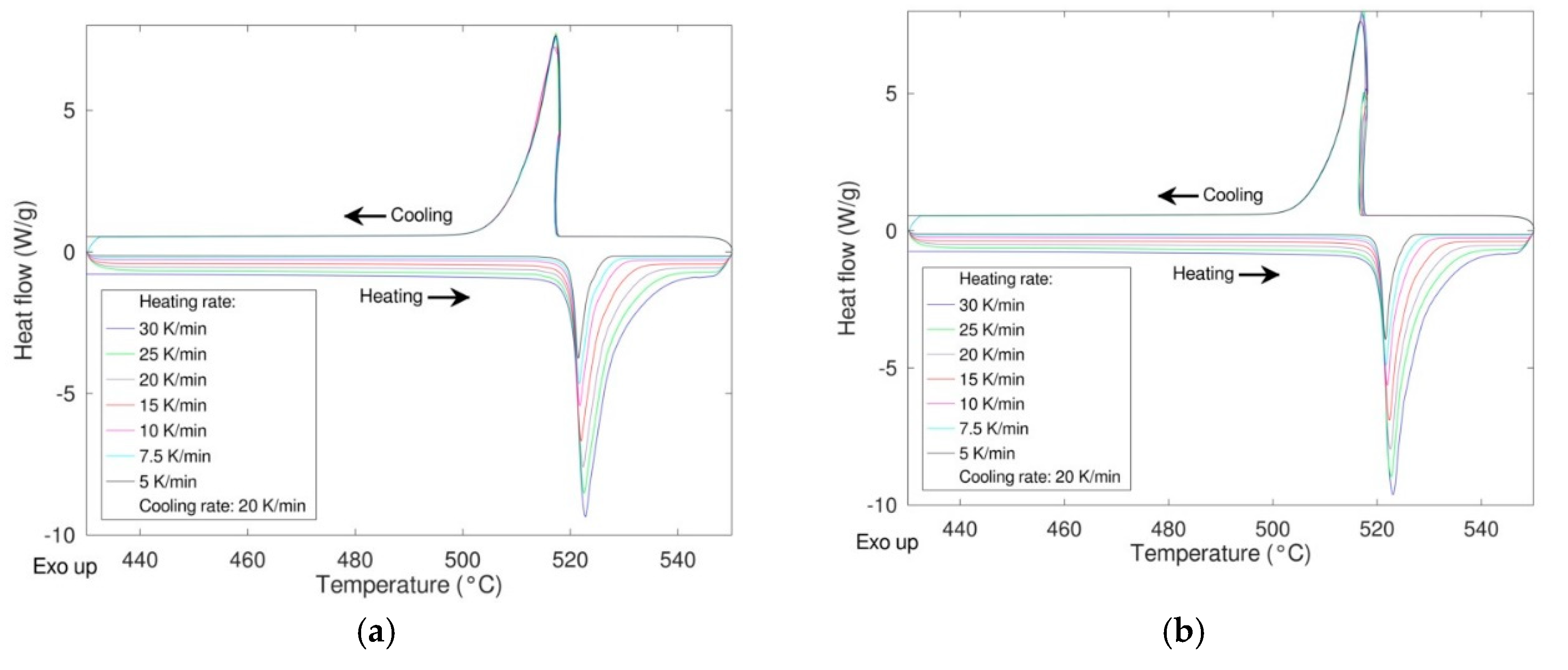
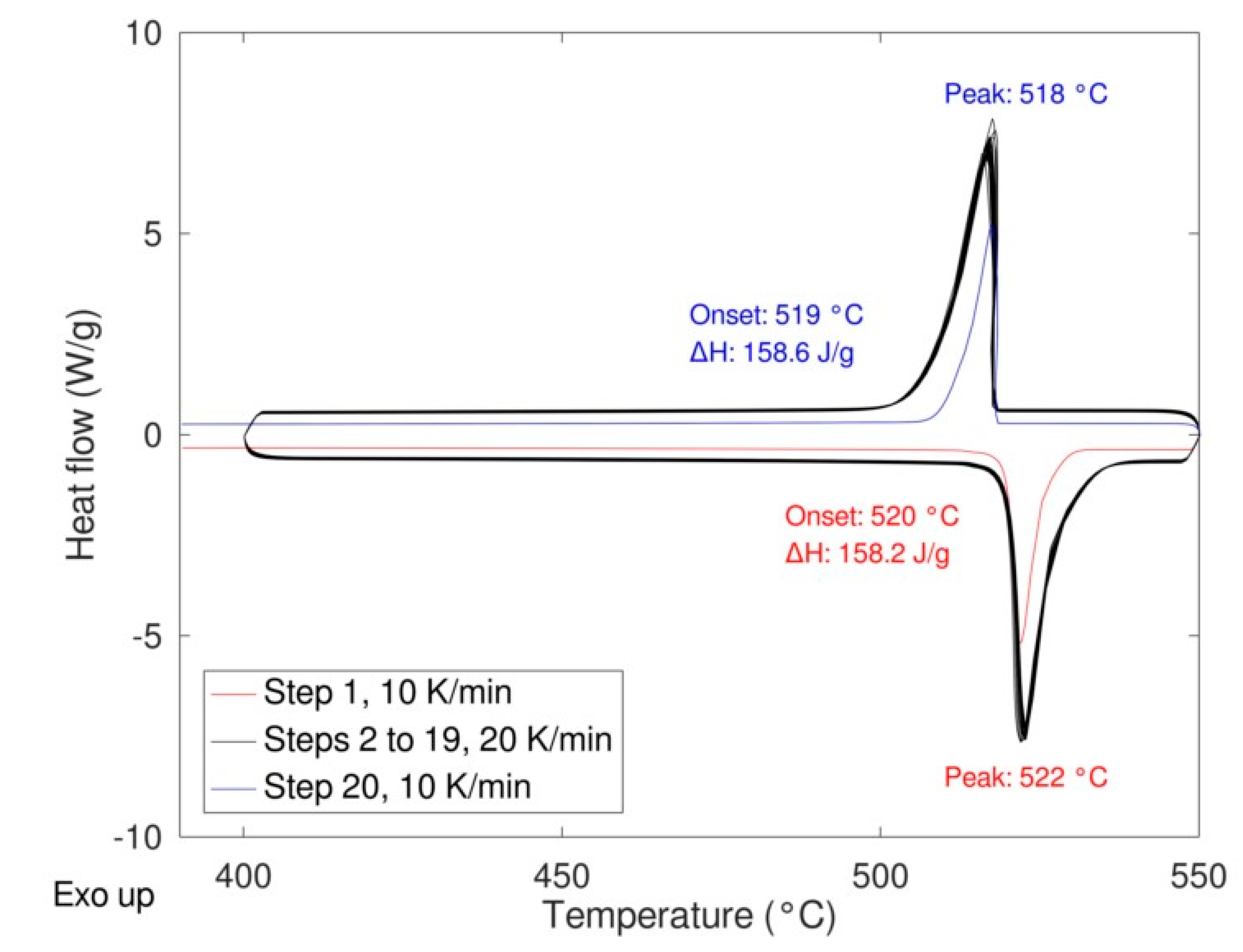
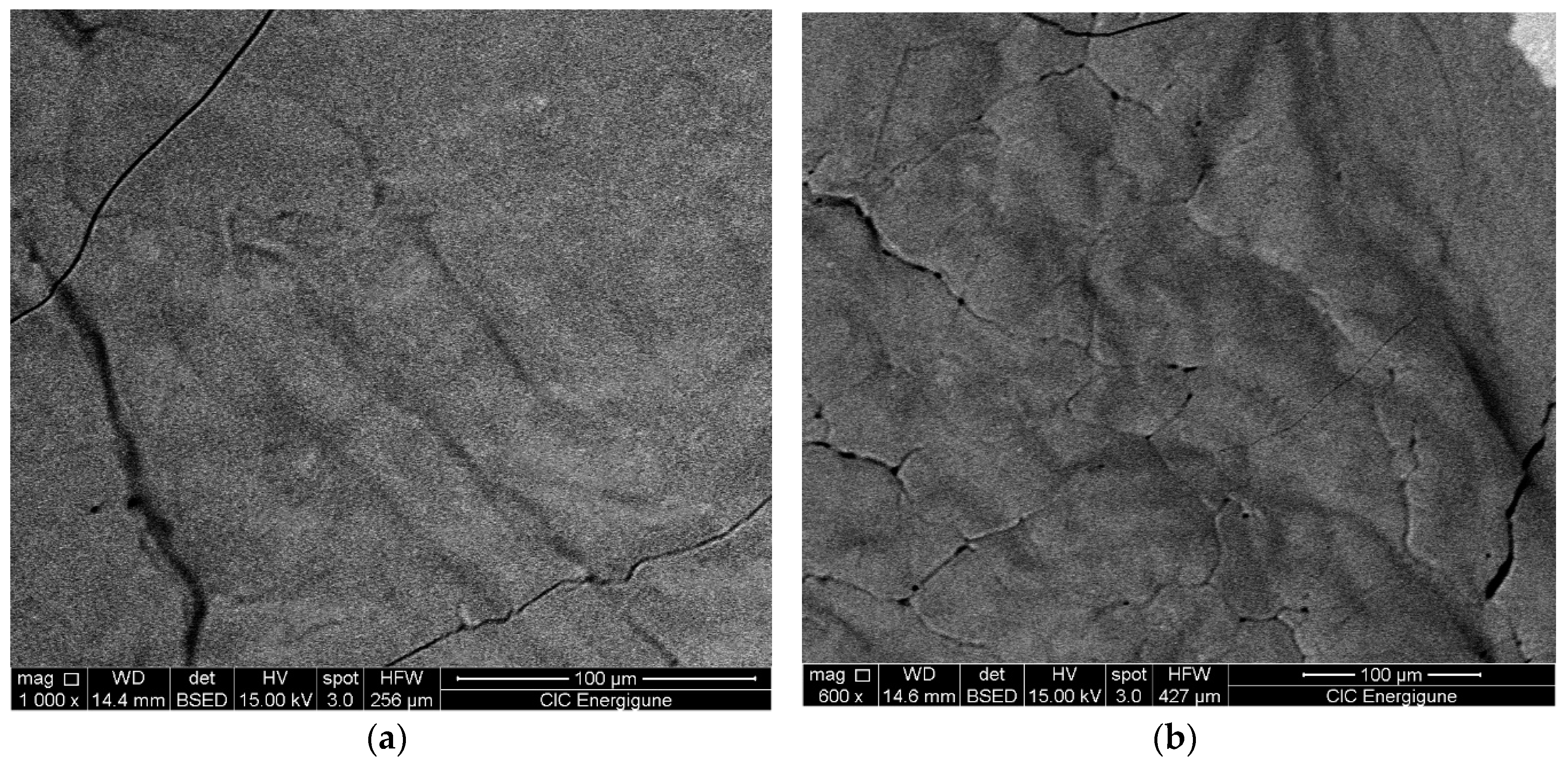
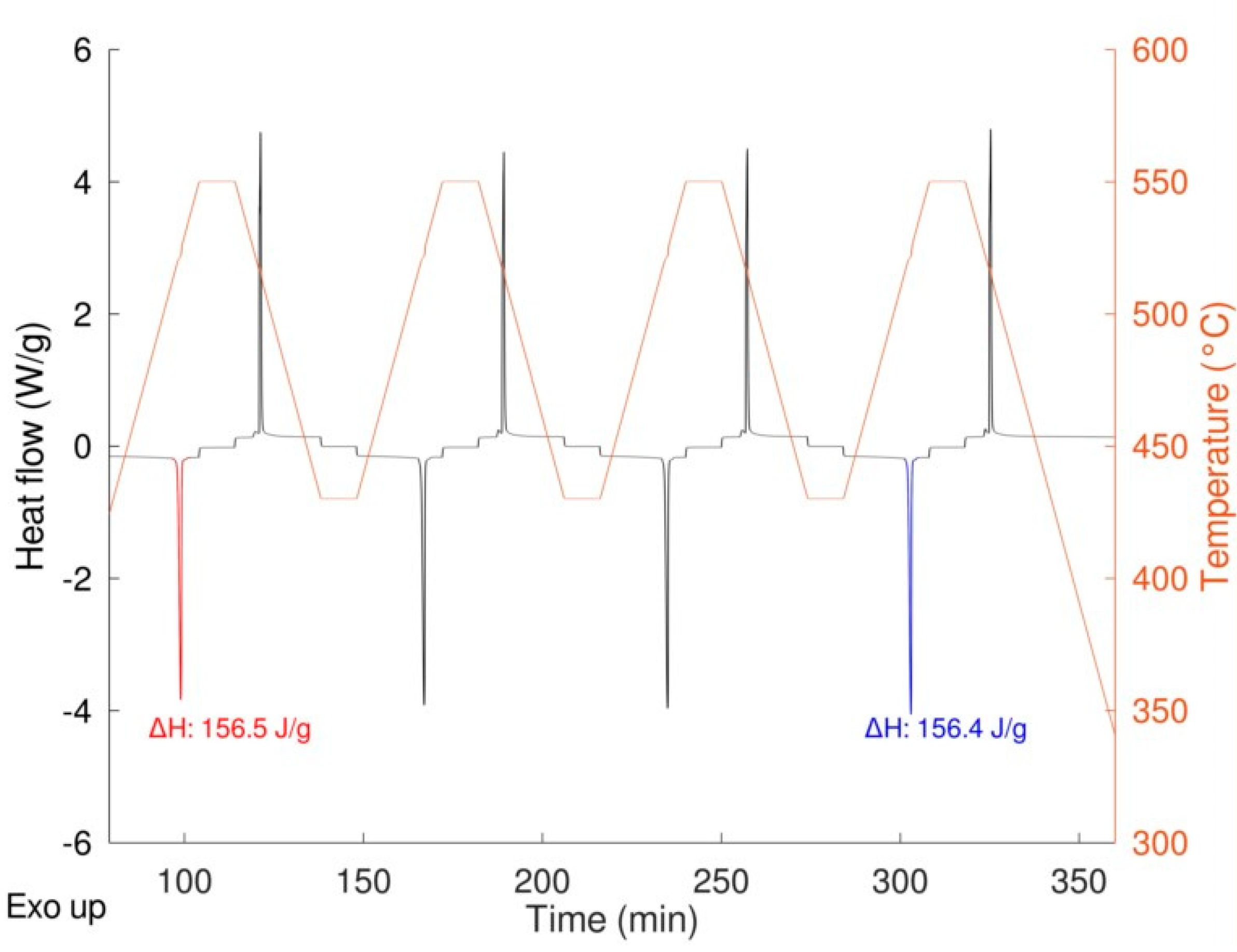
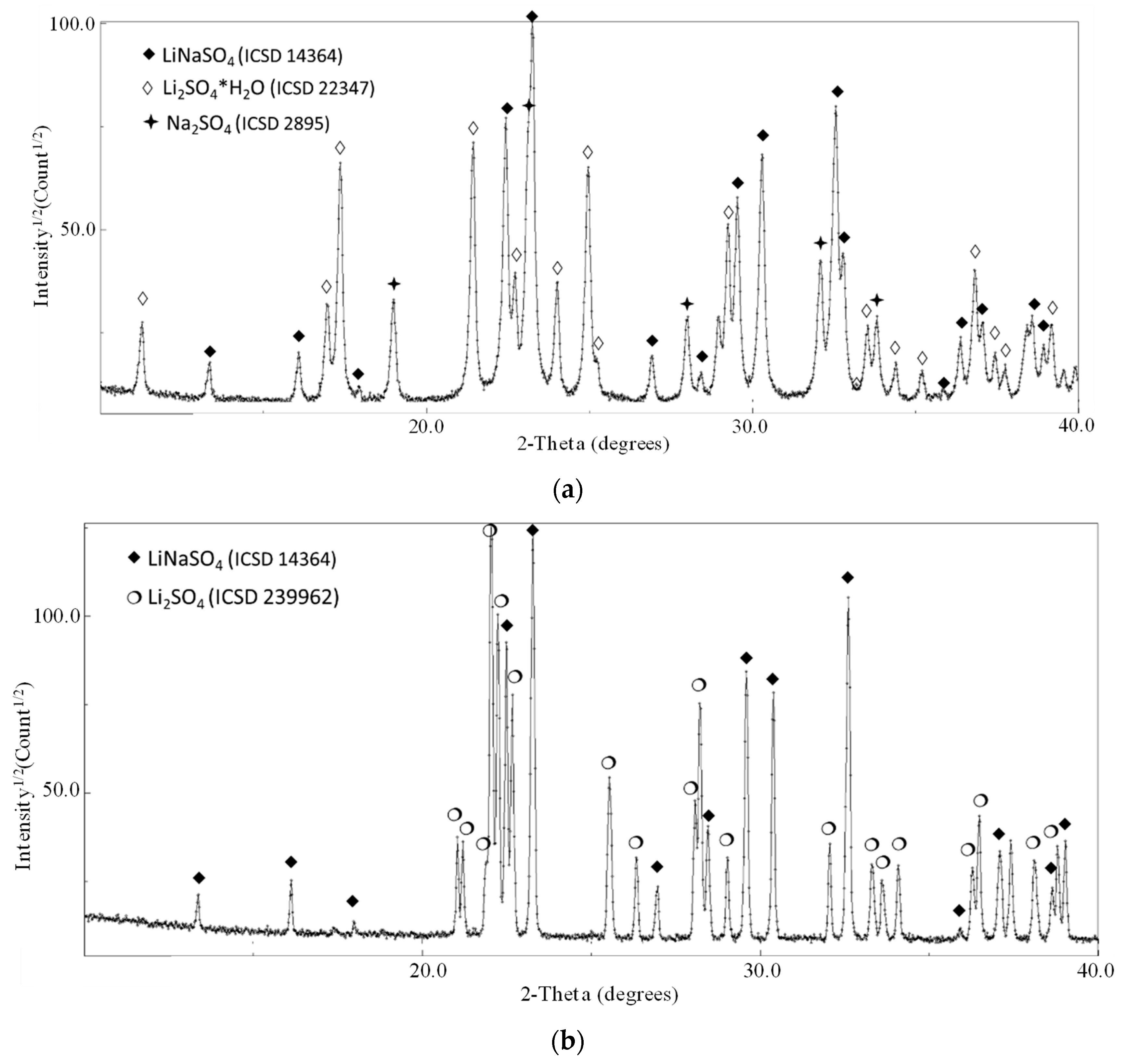
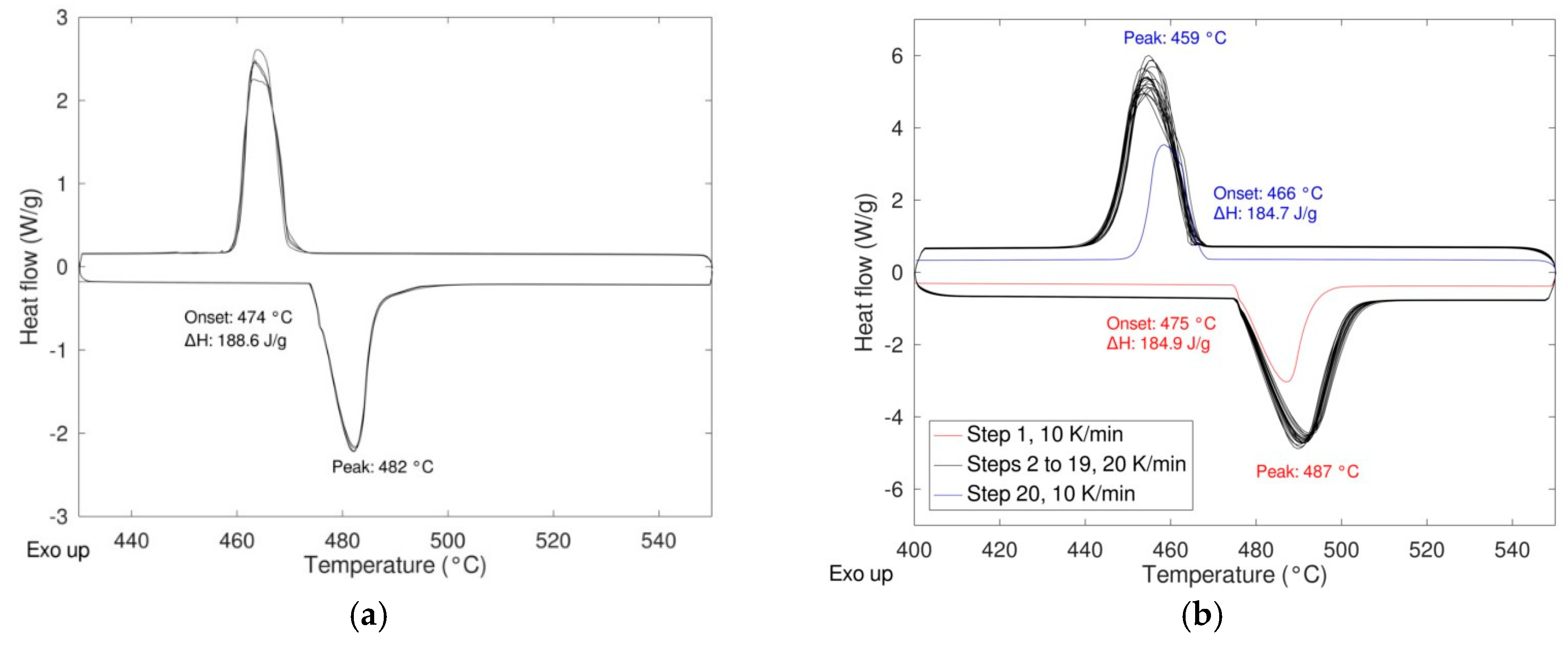
| Li2SO4/Na2SO4 | Temperature °C | ΔH kJ/mol | Volumetric Energy Density (kWh/ m3) | Density kg/m3 | Cp kJ/kg K |
|---|---|---|---|---|---|
| 50/50 | 515 | 40.080 (318 J/g) | 217 | 2458 | 1.72 |
| 79/21 | 470 | 31.530 (270 J/g) | 173 | 2309 | 1.58 |
| Li2SO4/Na2SO4 50/50 | LiNaSO4 a (nm) | LiNaSO4 c (nm) | LiNaSO4 <d> (nm) | LiNaSO4 Volume Fraction |
|---|---|---|---|---|
| 0 h BM + 15 min mixing | 0.7640 ± 1.14 × 10−5 | 0.9874 ± 2.51 × 10−5 | 169.8 ± 2.46 | – |
| 2 h BM + 15 min mixing | 0.7640 ± 1.14 × 10−5 | 0.9873 ± 2.51 × 10−5 | 189.2 ± 2.92 | 0.5982 ± 0.0117 |
| 8 h BM + 15 min mixing | 0.7636 ± 1.32 × 10−5 | 0.9868 ± 2.76 × 10−5 | 176.7 ± 3.30 | 0.6134 ± 0.0208 |
| 0 h + mix after heating | 0.7634 ± 7.58 × 10−4 | 0.9851 ± 1.16 × 10−3 | – | – |
| Latent | Li2SO4/Na2SO4 | ΔH Reaction/Transition J/g | Cp J/g.K | Density (Theoretical) kg/m3 | Volumetric Energy Density kWh/m3 |
| 50/50 | 160 | 2.19 | 2458 | 109 | |
| 79/21 | 185 | 1.6 | 2309 | 118 | |
| NaNO3[34] | 177 | 1.7 | 2.26 | 111 | |
| Sensible | Li2SO4/Na2SO4 | ΔH Reaction/Transition J/g | Cp J/g.K | CpΔT (ΔT = 100 K) J/g | Total Volumetric Energy Density kWh/m3 |
| 50/50 | 160 | 2.19 | 219 | 258 | |
| 79/21 | 185 | 1.6 | 160 | 221 | |
| Sand Rock [34] | 1.3 | 130 | 60 | ||
| Reinforced Concrete [34] | 0.85 | 58 | 50 | ||
| Magnetite [35] | 0.9 | 100 | 120 |
© 2019 by the authors. Licensee MDPI, Basel, Switzerland. This article is an open access article distributed under the terms and conditions of the Creative Commons Attribution (CC BY) license (http://creativecommons.org/licenses/by/4.0/).
Share and Cite
Doppiu, S.; Dauvergne, J.-L.; Serrano, A.; Palomo del Barrio, E. The Li2SO4–Na2SO4 System for Thermal Energy Storage. Materials 2019, 12, 3658. https://doi.org/10.3390/ma12223658
Doppiu S, Dauvergne J-L, Serrano A, Palomo del Barrio E. The Li2SO4–Na2SO4 System for Thermal Energy Storage. Materials. 2019; 12(22):3658. https://doi.org/10.3390/ma12223658
Chicago/Turabian StyleDoppiu, Stefania, Jean-Luc Dauvergne, Angel Serrano, and Elena Palomo del Barrio. 2019. "The Li2SO4–Na2SO4 System for Thermal Energy Storage" Materials 12, no. 22: 3658. https://doi.org/10.3390/ma12223658
APA StyleDoppiu, S., Dauvergne, J.-L., Serrano, A., & Palomo del Barrio, E. (2019). The Li2SO4–Na2SO4 System for Thermal Energy Storage. Materials, 12(22), 3658. https://doi.org/10.3390/ma12223658





